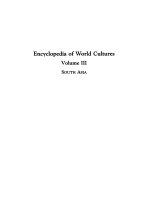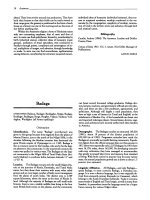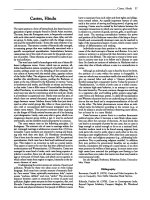Encyclopedia of World Cultures Volume III - South Asia - O doc

Encyclopedia of World Cultures Volume III - South Asia - O doc
... Puri and Ganjam districts, with houses almost in a continuous chain on both sides of the intervening village path and with kitchen gardens at the back of the houses. Cultivated fields surround the settlement. In the cluster pattern each house has a compound with fruit trees and a kitchen garden. The Scheduled Castes live in lin. ear or cluster hamlets slightly away from the main -settleme...
Ngày tải lên: 02/07/2014, 20:20

Encyclopedia of World Cultures Volume III - South Asia - A doc
... that life continues be- yond the grave, in a land where each of the uyus has its indi- vidual abode. When one dies, his or her soul is taken to the domain of the uyu who was the cause of death. An individual enjoys the same status and life-style that he or she had while alive. For this reason the deceased is provided with food, drink, possessions, and other tools and provisions to ensur...
Ngày tải lên: 02/07/2014, 20:20

Encyclopedia of World Cultures Volume III - South Asia - J docx
... a very large proportion of the population. Industrial Arts and Division of Labor. Among the agri- cultural Jat, traditionally only the men work in the fields, Jain 109 prime responsibility for digging the grave, but the Kurumba present also assists. When all is ready, the body is placed in the grave so that it faces toward the north. The local Irula priest (pujari) then gazes at a lamp an...
Ngày tải lên: 02/07/2014, 20:20

Encyclopedia of World Cultures Volume III - South Asia - K doc
... Crooke. 1920. London: Oxford University Press. Numerous reprints. PAUL HOCKINGS Tyler, Stephen A. (1972). "Fields Are for Planting: Notes on Koya Agriculture." In Proceedings of the Seminar on Tribal Studies, edited by D. P. Sinha. New Delhi: Government of India Press. STEPHEN A. TYLER Kurumbas Kshatriya ETHNONYMS: Alu-Kurumbas, Betta-Kurumbas, Jenu-Ku- rumbas, Kurubas, Mudugas,...
Ngày tải lên: 02/07/2014, 20:20

Encyclopedia of World Cultures Volume III - South Asia - S doc
... own paddy land, marriage (sidrung) may be arranged and a bride-price paid in buffalo or labor. But most marriages are by free choice (dari) with no payment. A woman and a man simply set up house together, though this often provokes difficulties with their families. Girls have considerable freedom to initiate relationships. Marriages are unstable in the early years and divorce is com- mon. Mar...
Ngày tải lên: 02/07/2014, 20:20

Encyclopedia of World Cultures Volume III - South Asia - Overview pot
... Contents Project Staff vi Contributors vii Preface xiii Introduction xix Maps 1. South Asia xxviii 2. Cultural Regions of South Asia xxix 3. Major Languages of South Asia xxx 4. Dominant Religious Groups of South Asia xxxi 5. Cultural Groups of South Asia xxxii Cultures of South Asia 1 Appendix: Additional Castes, Caste Clusters, and Tribes 309 Bibliograph...
Ngày tải lên: 02/07/2014, 20:20

Encyclopedia of World Cultures Volume III - South Asia - B potx
... that in Bilaspur they adopted Chhattisgarhi, in Mandla and Jub- bulpore they spoke a modified Eastern Hindi, in Balaghat they spoke Marathi, Hindi, Gondi (or a combination of Marathi, Hindi, and Gondi), and Baigani (a language of Indo-Aryan Stock belonging to the Indo-European Phylum). History and Cultural Relations Baiga contact with other peoples and knowledge of regions beyond their...
Ngày tải lên: 02/07/2014, 20:20

Encyclopedia of World Cultures Volume III - South Asia - C ppt
... to the government. The Chakma raja traditionally received a small portion of tax on swidden land. Kinship Kin Groups and Descent. The paribar (family) is the basic kinship unit in Chakma society. Beyond the paribar and bari (homestead), multihousehold compounds are the next widest unit, the members of which may form work groups and help each other in other activities. Next are the hamlets...
Ngày tải lên: 02/07/2014, 20:20

Encyclopedia of World Cultures Volume III - South Asia - D,E,F doc
... old culture is comprised of three main layers: the Tamil-Malayalam substratum with its many subtle roots; old Sinhala culture and language, which is the dominant element; and the phase of Arabic in- fluence. But the Maldives were touched by every cultural wind that passed over the Indian Ocean. Since independence there has again been influence from Sri Lanka, through its teachers brought...
Ngày tải lên: 02/07/2014, 20:20

Encyclopedia of World Cultures Volume III - South Asia - G pot
... is governed by repre- sentatives elected by universal adult franchise who constitute a vidhan sabha (legislative assembly). A majority party forms the government. The head of the state is the governor, ap- pointed by the president of India. The state government has very wide powers for maintaining law and order, levying taxes, and carrying out development work. It also shares resources wi...
Ngày tải lên: 02/07/2014, 20:20